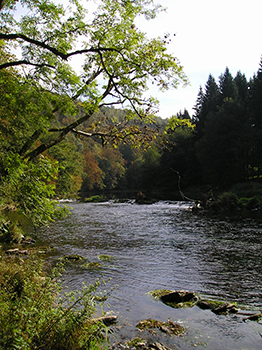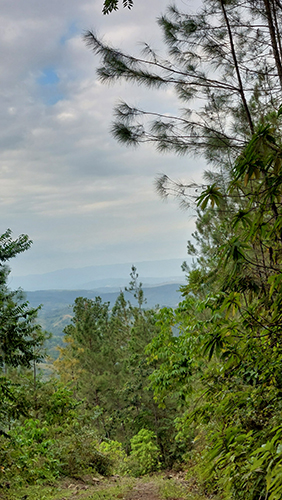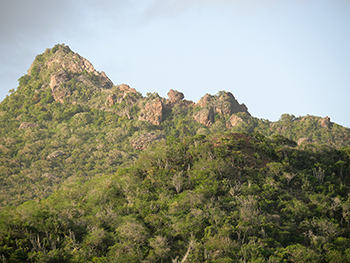This post is also available in: Dutch (below)
Click here for the other articles of the series: Forest series
This series of articles was written and published in 2011 in the Antilliaans Dagblad newspaper. 2011 was the year that the United Nations declared the International Year of Forests, in order to give more attention to the “lungs” of the earth. Without forests, life on earth is impossible. The original series concerned the mondi of Curaçao and has been adapted and rewritten where necessary to also include the sister islands of Aruba and Bonaire. This is part 3 of the series.
CO2 and O2
Forests worldwide have more than just the function of a habitat (place to live) for plants and animals. The large numbers of trees and other plants in forests together provide a large part of the oxygen that humans and other animals so desperately need to survive. The term ‘lungs of the earth’ is therefore often used. In this process of producing oxygen, the tree absorbs large amounts of CO2 (carbon dioxide) in its leaves, which is converted into carbohydrates (starches) by a chemical process called photosynthesis, which the tree uses for growth, reproduction and survival in harsh times. Oxygen is released during this photosynthesis process, in fact as a kind of waste product. But it is ‘waste’ that provides the basis for life. A considerable amount of the absorbed CO2 is stored in the leaves, roots and branches of the trees. In the meantime, it has become clear that although forests on land, including mangrove forests, do indeed produce large amounts of oxygen, this share is smaller than the oxygen produced by algae in the sea.
Forests and the climate

Forests have even more influence on the earth, beside oxygen production, than was initially suspected. Forests also influence the world’s climate, and have thus become ‘players’ in the battle against rapid global warming. The storage of CO2 in the tree is the key here. Due to the combustion of fossil fuels (such as oil and coal), there is an explosive increase in, among other things, CO2 in the atmosphere. This gas ensures that the heat from the sun that enters our atmosphere, and is normally reflected for the most part and sent back into space, remains within the atmosphere. This so-called greenhouse effect therefore results in the warming of the atmosphere, which in turn results in the melting of the ice caps on the poles and glaciers. Now, in the billions of years of history of the earth, this is not strange, the yo-yo effect of the climate becoming warmer and cooler. However, the warming is now happening much faster than it would due to purely natural causes. According to the calculations of various organizations, forests have the capacity to maintain a CO2 balance in the atmosphere by absorbing and storing the CO2 from the air. This counteracts the greenhouse effect, provided there are enough forests, of course. A welcome help in the doomsday scenario that is outlined around climate change.
Forests, however, have an influence on the climate in even more areas. For example, rainforests are also called the air conditioners of the earth by Greenpeace. Because they are warm and always humid, the rain that falls there evaporates continuously. The water vapor that comes from this cools the air above the forest and directly influences the climate. All in all, forests are therefore indispensable in the fight against climate change.
Forests are disappearing at a rapid pace

That this idea is not a common good is evident from the speed at which primary forests are disappearing around the world. For example, an area of Amazon rainforest the size of no less than 6 football fields disappears every minute and the rate of disappearance elsewhere in the world, such as Indonesia and Congo, is no less. With every piece of forest that is cut down, the CO2 stored in it is largely released back into the atmosphere and there is less capacity for future storage.
Protecting forests seems a piece of cake. Keep your hands off them and we don’t have to worry about anything, is what many people think. The big problem, however, is that most tropical primary forests are located in countries that are doing very badly economically. There is little budget in these countries to build basic infrastructure, let alone take protective measures. Large multinational logging companies usually establish themselves in these types of countries because there are few to no regulations, labour wages are low, and therefore wood can be supplied at low prices, but with maximum profits. Often, forests are also cut down or burned to expand arable farming and livestock farming, usually illegal practices that are fueled by the expanding population and the increasing demand for food for both humans and animals. The ‘big picture’ logically plays no role in the daily struggle for survival of the farmers in question.
Is reforestation the solution?

Reforestation is often put forward as a simple solution to the greenhouse effect. If we only planted enough trees, the greenhouse effect would be solved by itself. Many of us are happy to participate in this to feel less guilty about the greenhouse gases emitted with our umpteenth overseas flight. It can’t do any harm, but it certainly won’t be the only solution to the problem. The world is demanding more and more food, and more and more energy. Due to the increasing world population, more food is needed, which means more agricultural land for which forests have to make way. We all want to drive our own car, go on holiday to foreign paradises, and eat shrimp that come from the Philippines. All energy, and therefore fossil fuel-guzzling desires. Poor countries want to develop to the level of prosperity of rich countries and with that also the energy behaviour of these ‘guzzlers’. It seems like a vicious circle from which the world can hardly escape.

Bossen op de semi-aride ABC-eilanden (3) – Bossen en het klimaat
Deze artikelenserie werd in 2011 geschreven en gepubliceerd in het Antilliaans Dagblad. 2011 was het jaar dat door de Verenigde Naties werd uitgeroepen tot het internationaal jaar van de bossen, om zodoende de “longen” van de aarde meer aandacht te geven. Zonder bossen is leven op aarde namelijk onmogelijk. De oorspronkelijke serie betrof de mondi van Curaçao en is aangepast en waar nodig herschreven om ook de zustereilanden Aruba en Bonaire er ook in mee te nemen. Dit is deel 3 van de serie.
CO2 en O2
Wereldwijd hebben bossen meer dan alleen de functie van een habitat (plek om te leven) voor planten en dieren. De grote hoeveelheden bomen en andere planten in bossen zorgen samen voor de levering van een flink deel van de zuurstof die de mens en andere dieren zo broodnodig hebben om te overleven. De benaming ‘longen van de aarde’ wordt dan ook vaak gebruikt. Bij dit proces van zuurstof produceren neemt de boom grote hoeveelheden CO2 (koolstofdioxide) op in zijn bladeren dat door een chemisch proces, dat fotosynthese wordt genoemd, wordt omgezet in koolhydraten (zetmelen) die de boom gebruikt voor de groei, voortplanting en het overleven in barre tijden. Bij dit fotosynthese proces komt zuurstof vrij, in feite als een soort afvalproduct. Maar wel ‘afval’ dat de basis voor leven geeft. Een aanzienlijke hoeveelheid van de opgenomen CO2 wordt opgeslagen in de bladeren, wortels en takken van de bomen. Ondertussen is duidelijk dat alhoewel bossen op het land, waaronder mangrovebossen, inderdaad grote hoeveelheden zuurstof produceren, dit aandeel kleiner is dan de zuurstof die wordt geproduceerd door algen in de zee.
Bossen en het klimaat

Bossen hebben nog meer invloed op aarde dan men in eerste instantie vermoedde. Bossen beïnvloeden ook het klimaat op de wereld, en zijn daarmee ‘players’ geworden in de strijd tegen de snelle opwarming van de aarde. De opslag van CO2 in de boom is hierbij de clou. Door de verbranding van fossiele brandstoffen (zoals olie en steenkool) is er een explosieve toename van, onder andere, CO2 in de atmosfeer. Dit gas zorgt er voor dat de warmte van de zon die onze atmosfeer binnenkomt, en normaal voor het grootste deel weerkaatst en terug de ruimte in wordt gezonden, binnen de atmosfeer blijft. Dit zogenaamde broeikaseffect heeft dus als resultaat het opwarmen van de atmosfeer met onder andere als gevolg het smelten van de ijskappen op de polen en gletsjers. Nu is dat in de miljarden jaren geschiedenis van de aarde niet vreemd, het jojo effect van warmer en koeler worden van het klimaat. De opwarming gaat nu echter veel sneller dan het zou doen door als gevolg van puur natuurlijk oorzaken.
Volgens de rekensommen van verschillende organisaties hebben bossen de capaciteit om een CO2-balans in de atmosfeer te behouden door de CO2 uit de lucht op te nemen en op te slaan. Daarmee wordt dan het broeikaseffect tegengegaan, mits er voldoende bossen zijn, natuurlijk. Een welkome hulp in het doemscenario wat rondom de verandering van het klimaat wordt geschetst.
Bossen hebben echter op nog meer vlakken invloed op het klimaat. Zo worden bijvoorbeeld regenwouden door Greenpeace ook wel de airco’s van de aarde genoemd. Doordat ze warm en altijd vochtig zijn verdampt de regen die er valt continue. De waterdamp die hier vanaf komt koelt de lucht boven het woud af en beïnvloed op directe wijze het klimaat. Al met al zijn bossen dus onmisbaar in de strijd tegen klimaatsverandering.
Bossen verdwijnen in rap tempo

Dat deze gedachte geen algemeen goed is blijkt uit de snelheid waarmee oerbossen verdwijnen op de wereld. Zo verdwijnt er per minuut een oppervlakte amazonewoud ter grootte van maar liefst 6 voetbalvelden en is de ratio van verdwijning elders op de wereld, zoals Indonesië en Congo, niet minder. Bij elk stuk bos wat wordt weggekapt, komt de daarin opgeslagen CO2 voor een groot deel weer vrij in de atmosfeer en is er minder capaciteit voor toekomstige opslag ervan.
De bescherming van bossen lijkt een fluitje van een cent. Blijf er met je tengels vanaf en we hoeven ons nergens zorgen om te maken, is wat veel mensen denken. Het grote probleem is echter dat de meeste tropische oerbossen in landen staan die het economisch bijzonder slecht hebben. Er is in deze landen weinig budget om basisinfrastructuur aan te leggen, laat staan beschermingsmaatregelen te treffen. Grote multinationale houtkapbedrijven vestigen zich meestal in dit soort landen, omdat er weinig tot geen regelgeving is, arbeidslonen laag liggen, en daardoor hout tegen lage prijzen geleverd kan worden, maar wel met maximale winsten. Vaak worden er ook stukken bos weggekapt of weggebrand voor het uitbreiden van akkerbouw en veeteelt, meestal illegale praktijken die gevoed worden door de uitbreidende bevolking en de stijgende vraag naar voedsel voor zowel mens als dier. De ‘big picture’ speelt logischerwijs geen rol in de dagelijkse overlevingsstrijd van de boeren in kwestie.
Is herbebossing de oplossing?

Als simpele oplossing voor het broeikaseffect wordt dikwijls herbebossing naar voren gebracht. Als we maar genoeg bomen zouden planten zal het broeikaseffect vanzelf worden opgelost. Velen van ons doen daar graag aan mee om onszelf minder schuldig te voelen over de broeikasgassen die worden uitgestoten met onze zoveelste vliegreis overzee. Het kan ook geen kwaad, maar zal ook zeker niet de oplossing zijn van het probleem. De wereld vraagt steeds meer voedsel, en steeds meer energie. Door de toenemende wereldbevolking is er meer voedsel nodig, dus meer landbouwgrond waar bossen voor moeten wijken. We willen allemaal in onze eigen auto rijden, op vakantie in buitenlandse paradijzen, en garnalen eten die uit de Filipijnen komen. Allemaal energie, en dus fossiele brandstof verslindende wensen. Arme landen willen zich graag ontwikkelen tot het niveau van welstand van de rijke landen en daarmee ook het energiegedrag van deze ‘slurpers’. Het lijkt een vicieuze cirkel waar de wereld nauwelijks meer uit kan komen.